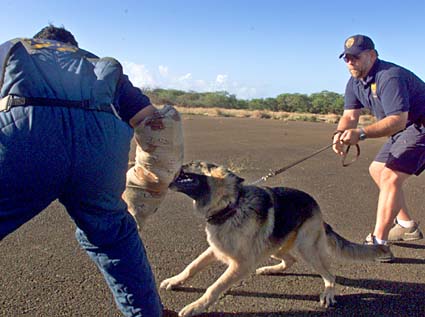
DEAN SENSUI / DSENSUI@STARBULLETIN.COM
Conservation officers with the state Department of Land and Natural Resources often train with their dogs at Kalaeloa. Officer Michael Harken, with his dog Bear on leash, gets an aggressive suspect, played by officer Harvey Kamai, under control. Dogs are trained in "controlled aggression," meaning they will go only as far as they are told to go.
Pooches on patrol
Conservation officers patrol
state parks and harbors with
the help of man's best friend
When state Conservation Officer Michael Harken takes his dog, Bear, out of the back of his Chevy Silverado in Waikiki, heads turn.
The 80-pound Alsatian, a type of German shepherd, is calm and prompt to follow his master's commands. His eyes and ears scan around him as he strides down Kuhio Beach.
The burly, 6-foot-2-inch Harken wears a blue polo shirt, "Police K9 DLNR" in large letters on the back, and has a pistol strapped to his leg.
You can almost hear the thoughts of beach-goers: Can that dog sniff drugs? Are they looking for somebody? Does he bite?
"I can tell the way people act and look, they're not sure what the dog can do," Harken says.
The Thursday was just another day on the job for the partners, one of seven man-and-dog teams that work for the state Department of Land and Natural Resources in its Division of Conservation and Resources Enforcement.
On the beach, Harken greets beach boys manning their stands, talking story a few minutes under the shade of their umbrellas.
Checking that everyone offering surf lessons has a state license is one of the myriad tasks Harken undertakes as he and Bear patrol from Makapuu Point to Pearl Harbor.
With or without a dog, conservation officers are the cops of the DLNR, which oversees state parks, boating and ocean recreation, forestry and wildlife, as well as land use. The rules they enforce fill several fat law books that Harken keeps for reference behind the seat of his truck.
DEAN SENSUI / DSENSUI@STARBULLETIN.COM
As Harken puts handcuffs on Kamai, Bear remains on watch. Harken can call Bear to assist in case the suspect suddenly becomes aggressive.
On any day, Harken might investigate a complaint of an illegal seawall, ticket cars illegally parked at the Ala Wai or Keehi Lagoon small-boat harbors, disperse people drinking in a state park or cite boaters for not having proper safety equipment.
Much of Harken and Bear's patrolling is by land, moving from one state park, harbor or recreation area to another. Some days they patrol in a 22-foot Boston Whaler.
"He digs it," Harken says.
Harken describes Bear's job this way: "Ninety-nine percent of the dog's job is deterrent. ... You don't know how many violations or what you might deter by his presence.
"When you have a group of intoxicated males in a state park at night (and approach them with a dog), it's easier to get compliance," Harken says. "My goal is not to arrest them, but to get them out of the park."
Bear and his fellow patrol dogs also are trained to detect humans -- whether walking unexpectedly around the back of a parked vehicle or hurt and lost in the mountains.
And the dogs do bite -- if told to.
Though Harken has been training with Bear for two years, the dog has been certified for patrol only since June. The partners trained and trained in "controlled aggression."
That means the dog goes only as far as the trainer tells him to go. "If I have a report of someone threatening people in Waahila State Park, and I get there and see a guy and he runs away from me when I want to talk to him, I'd say, 'Stop or I'll send my dog,'" Harken says.
If the suspect stops, the dog has to stop, too.
"Honestly, I hope I never have to send Bear to bite anybody," Harken says.
As Harken drives up Nuuanu Pail Drive, a man approaches the road with a shoulder-load of freshly cut bamboo. Sure sign of an amateur, he notes. The repeat offenders sneak their illegal cuttings out through untraveled places, not on a marked trail like Jackass Ginger.
Harken gives him a lecture and a warning, instead of a citation with a potential fine of $1,000.
"You cannot cut all bamboo in the forest reserve," Harken tells him. "You can't just come up here and take plants. If everybody did that, there would be nothing left. If I catch you again, I'll give you a citation."
Harken logs each day's interactions into a computerized database and can pull them up in the future by name or license number. Repeat offenders get no mercy.
Becoming a canine officer is voluntary. The dog is owned by the state, and it pays for food and veterinary bills. But the dogs live at their handlers' homes and are their responsibility.
Care and maintenance of the seven working dogs cost about $12,000 last year, and each has an effective working life of about eight years.
Regular shifts switch between day and afternoon, but on occasion, the dogs come out at night, such as during a "harbor sweep" for people drinking alcohol or using drugs.
When there's a missing hiker, the canine officers and their dogs may be called in to help search.
Across the state, dogs have helped bring dozens of lost tourists to safety, says Tarey Tow, a canine officer on Kauai.
"You cannot put a price label on anyone's life," Tow says.
"The majority of law enforcement agencies have canine units," but they are used for drug-sniffing, bomb detection and other specialized jobs, says Thomas Tanaka, who patrols the North Shore with his dog, Kuma (Japanese for "bear"). "Only ours are on patrol."

